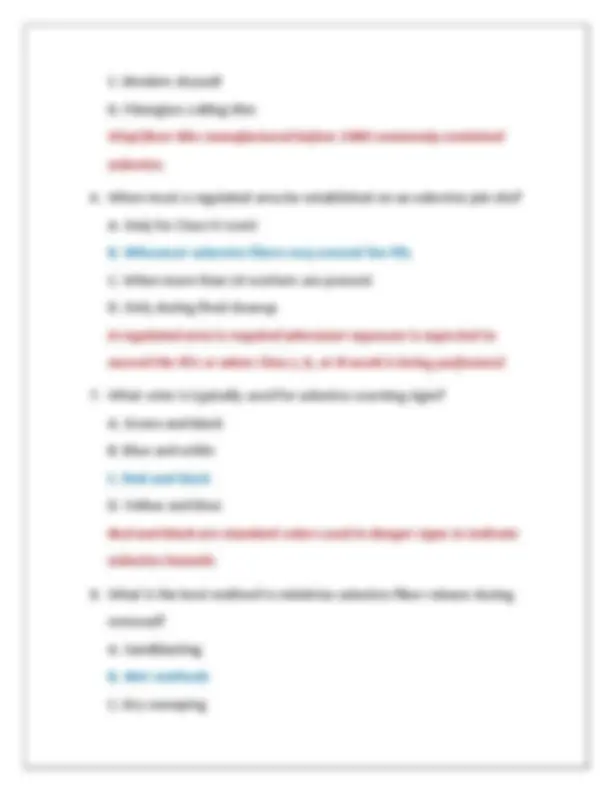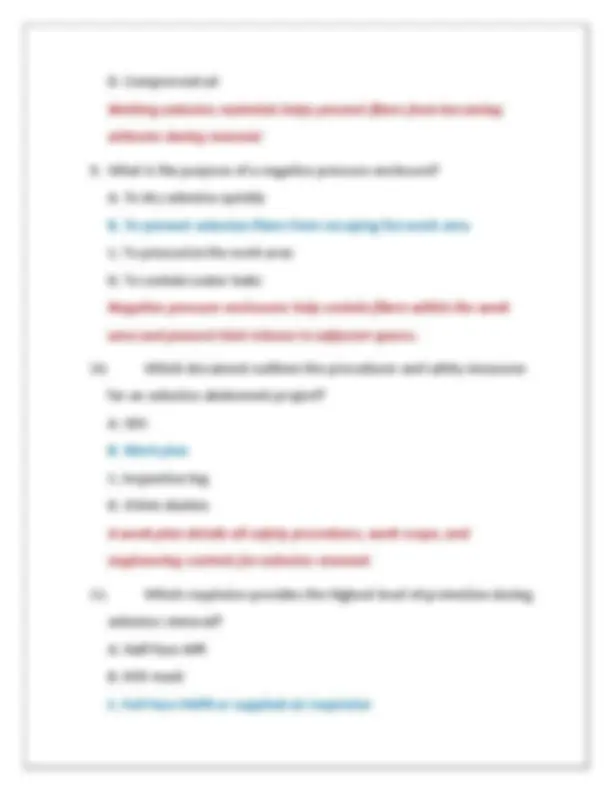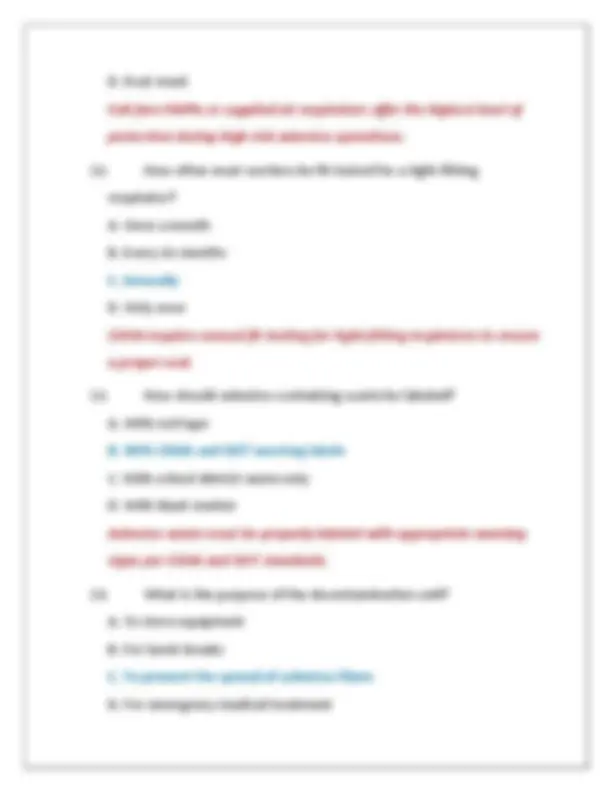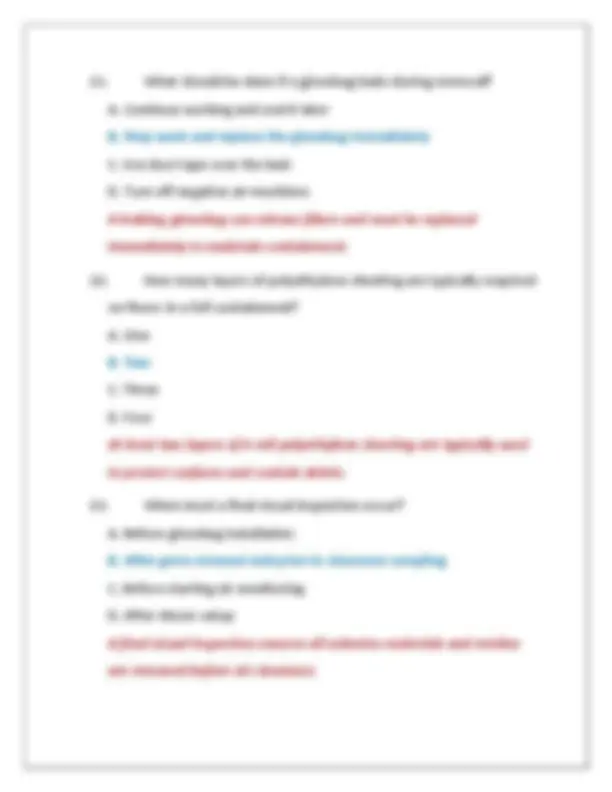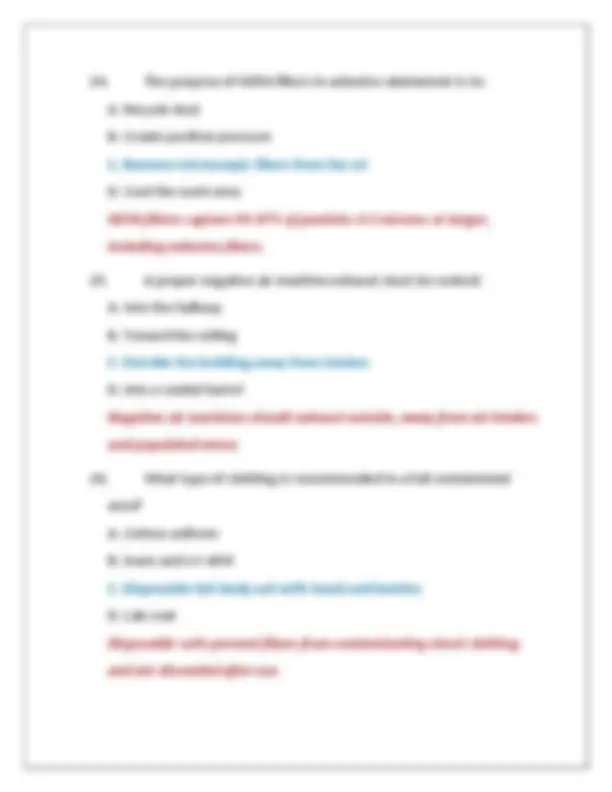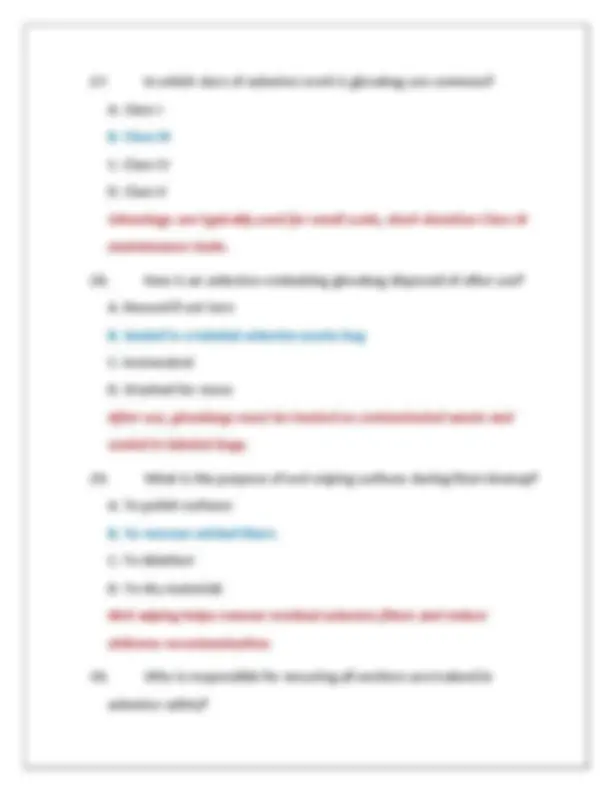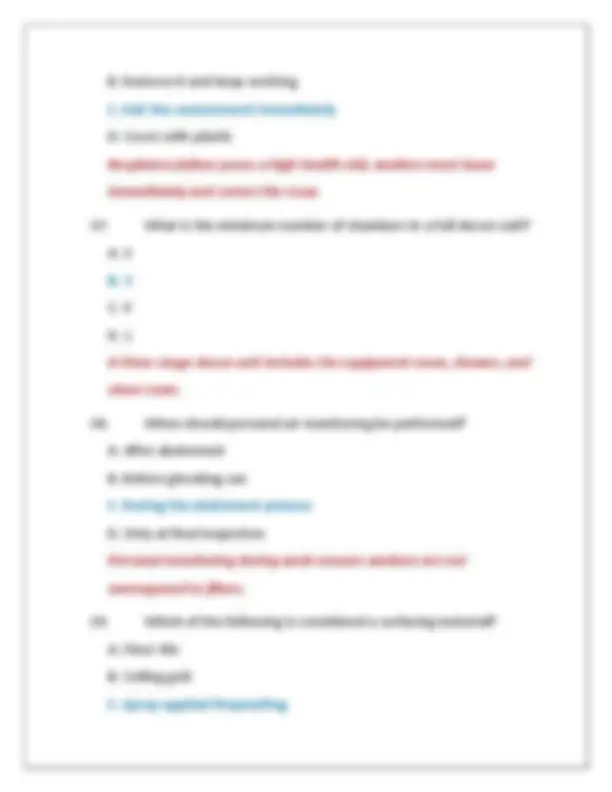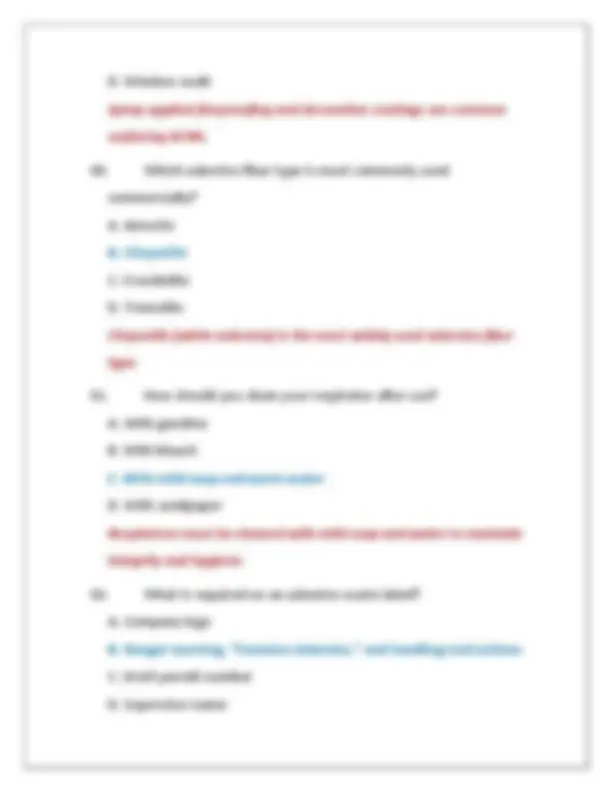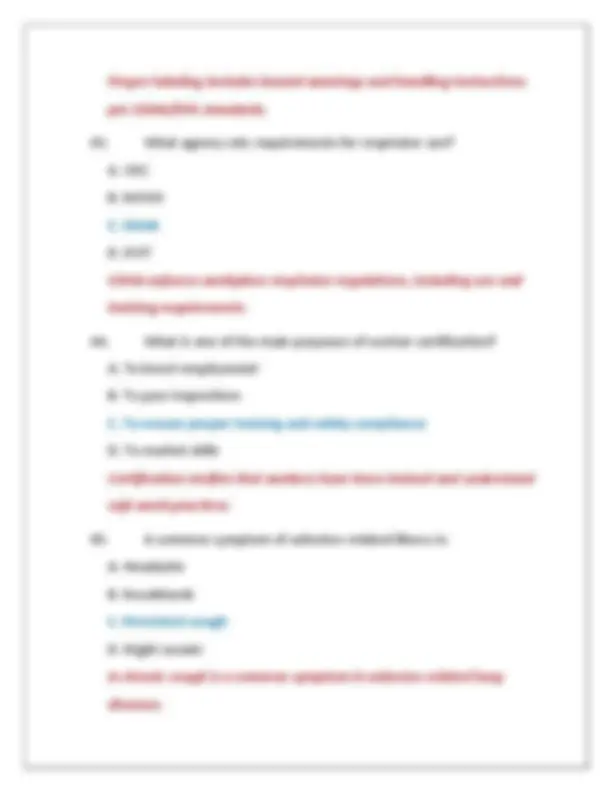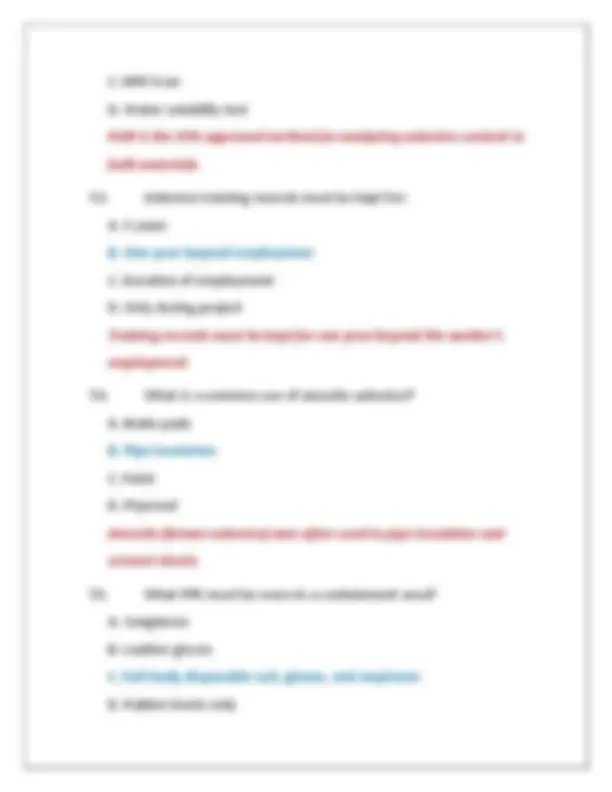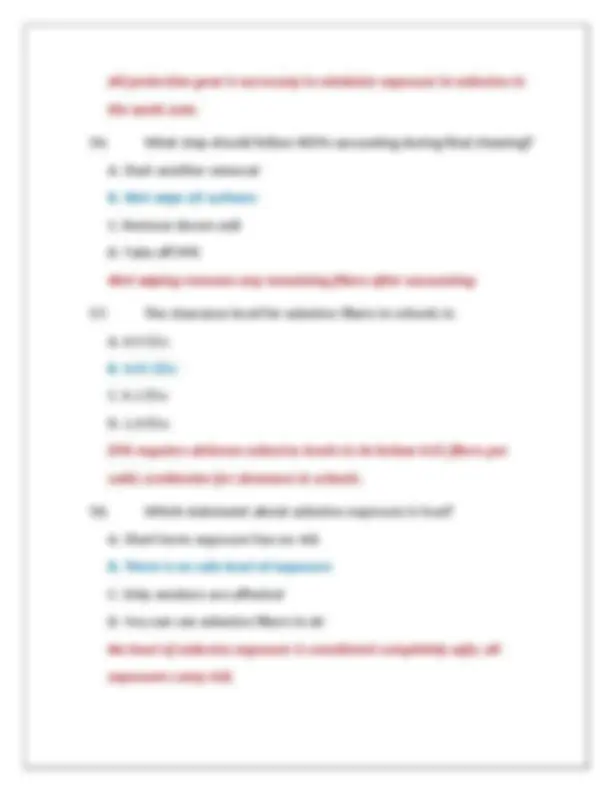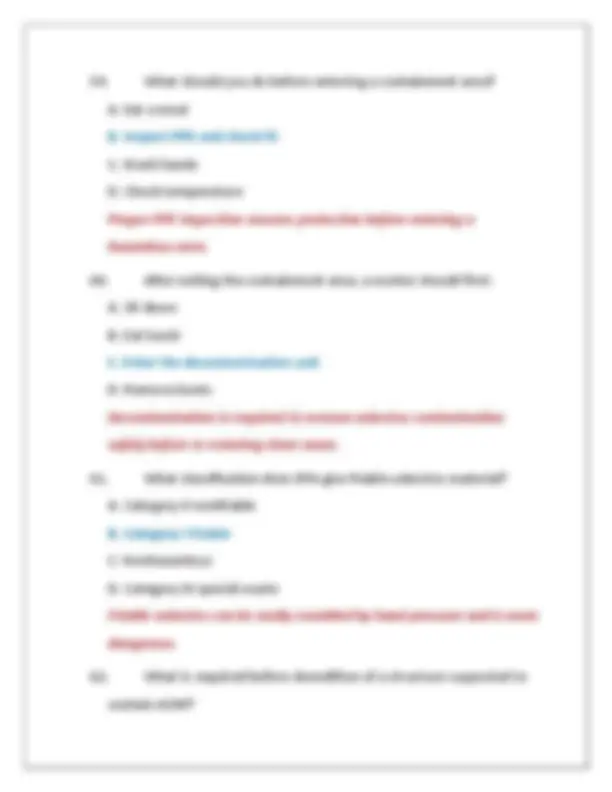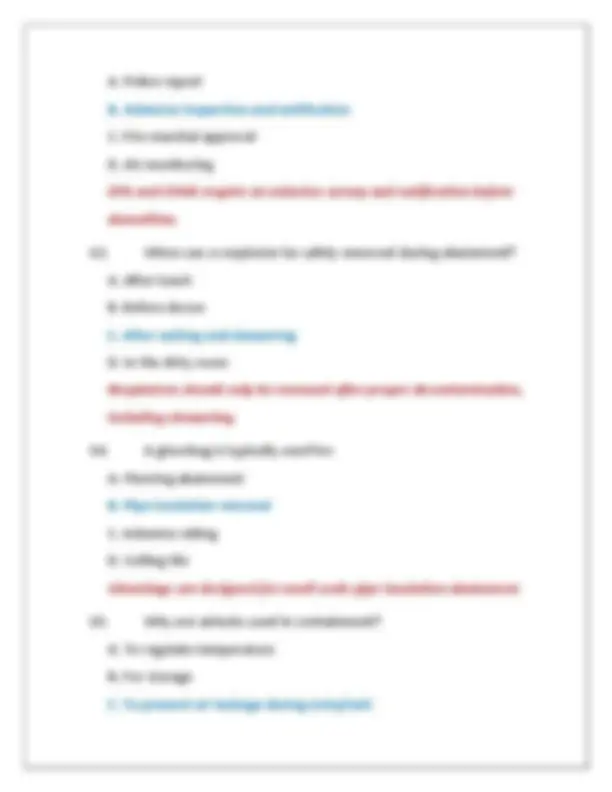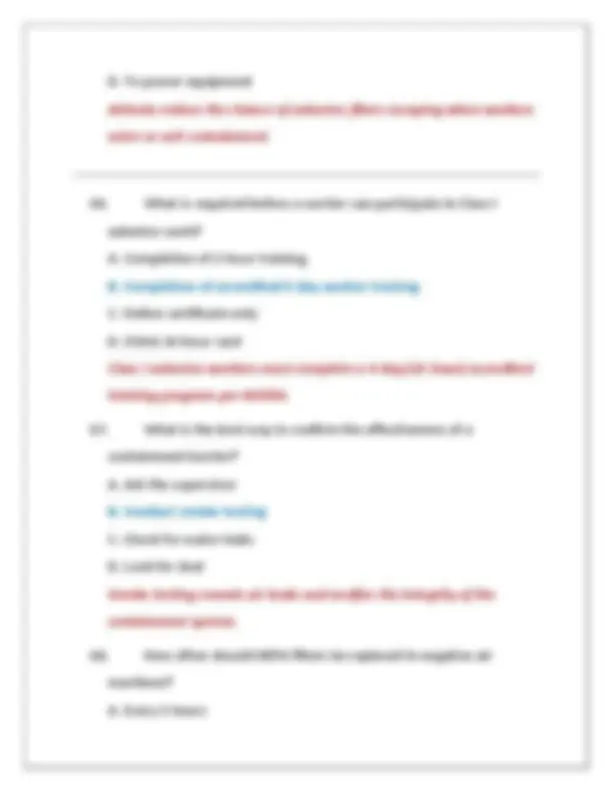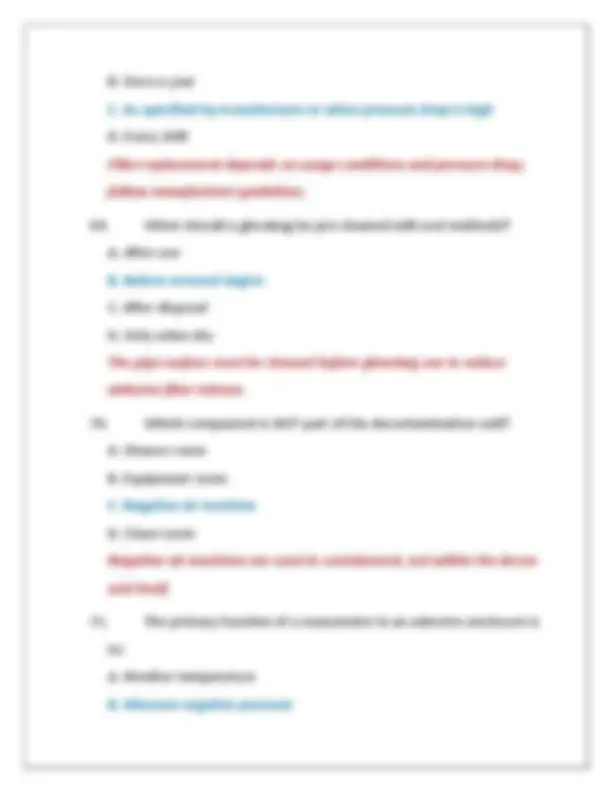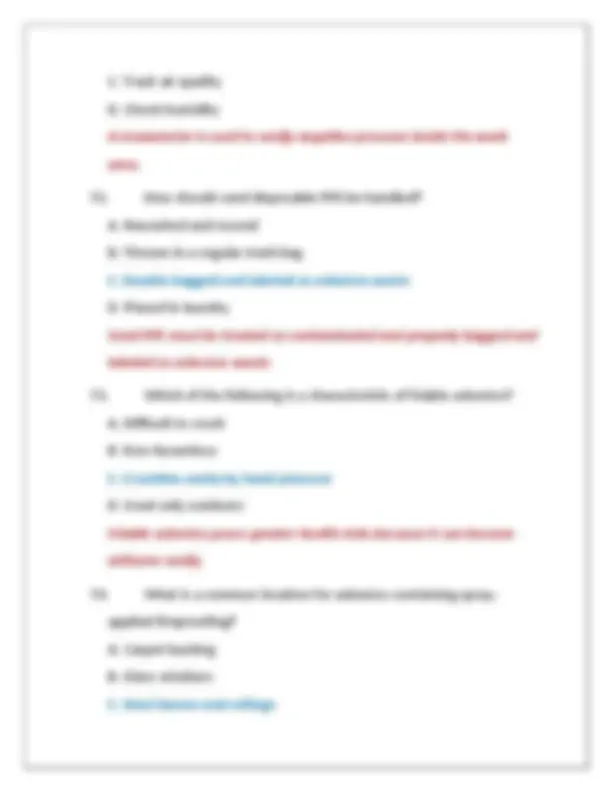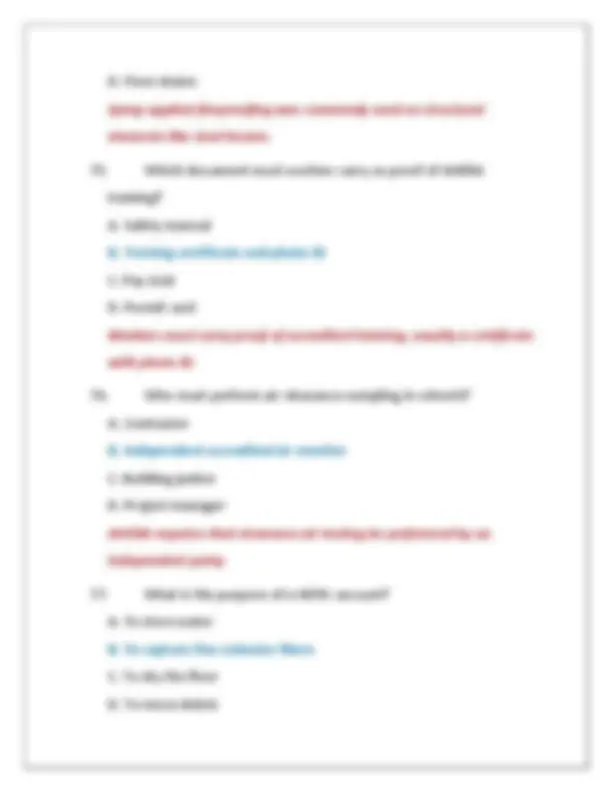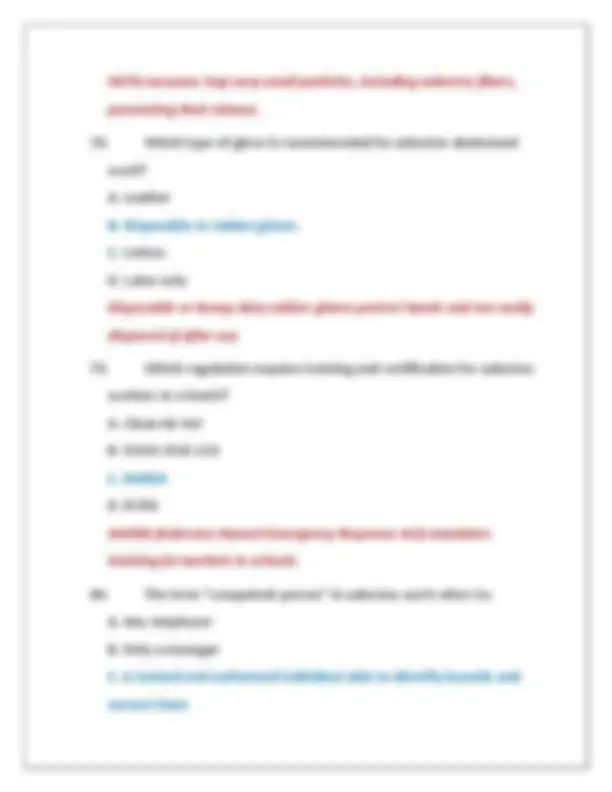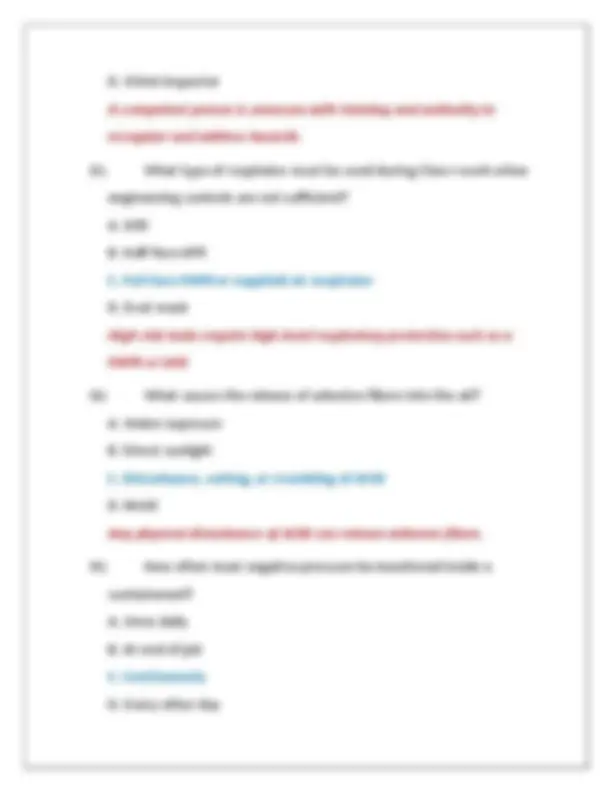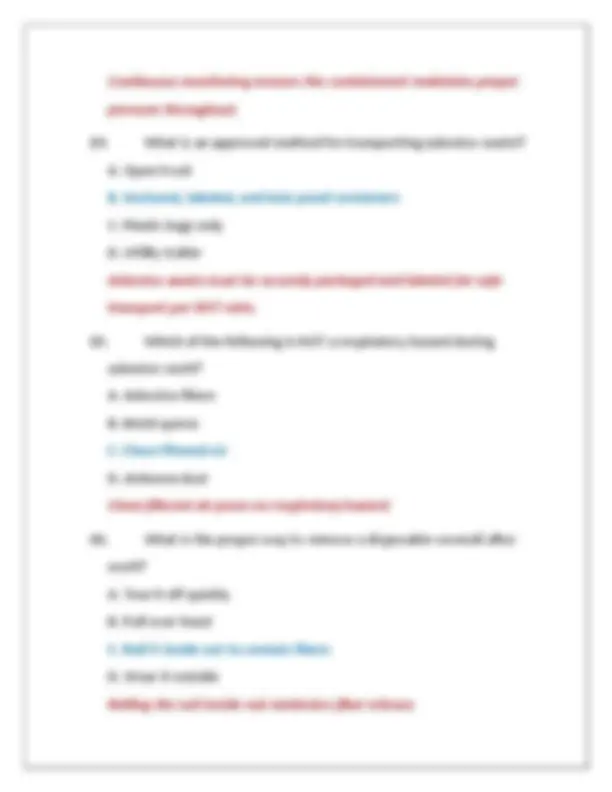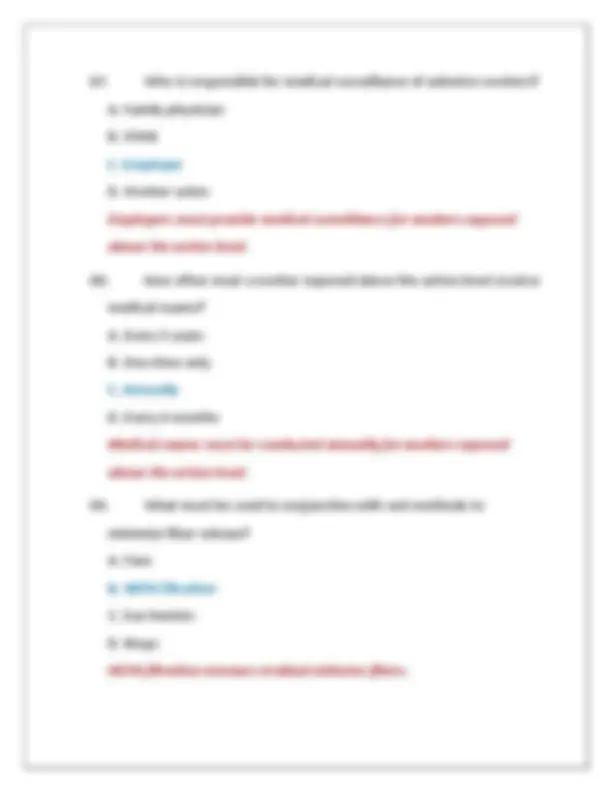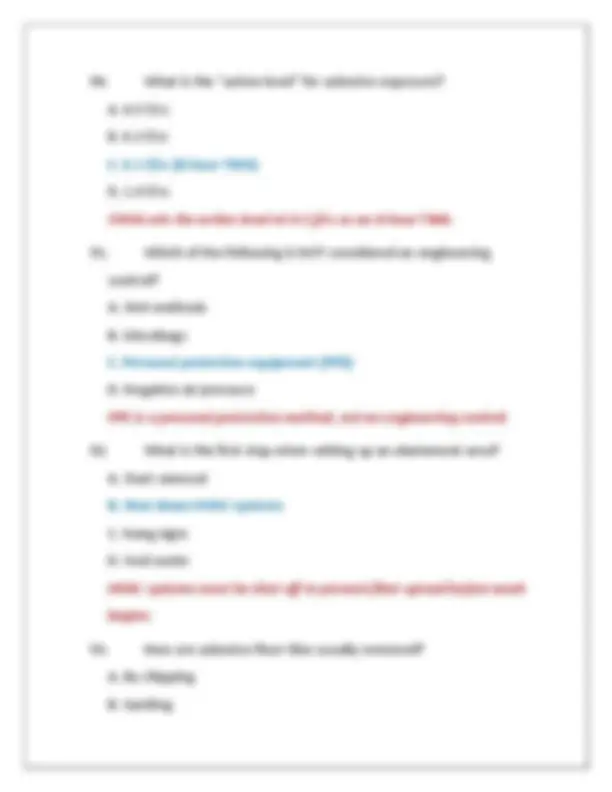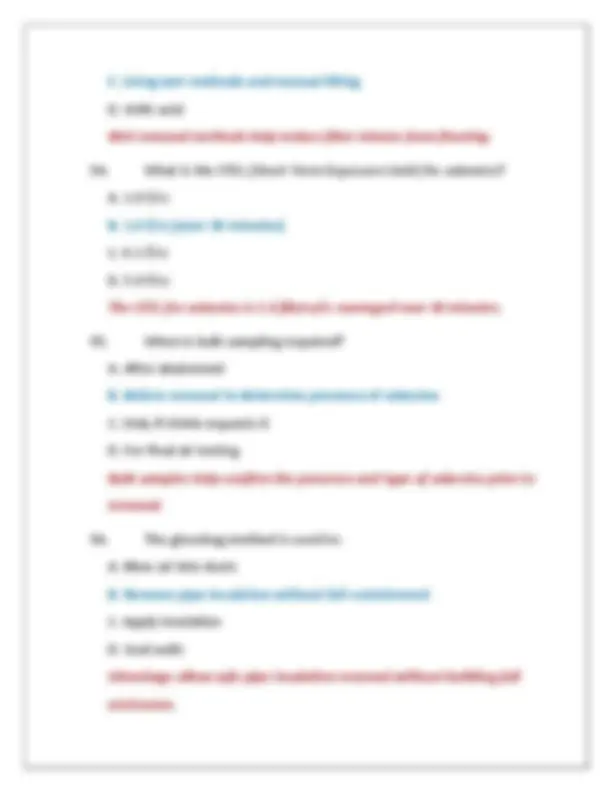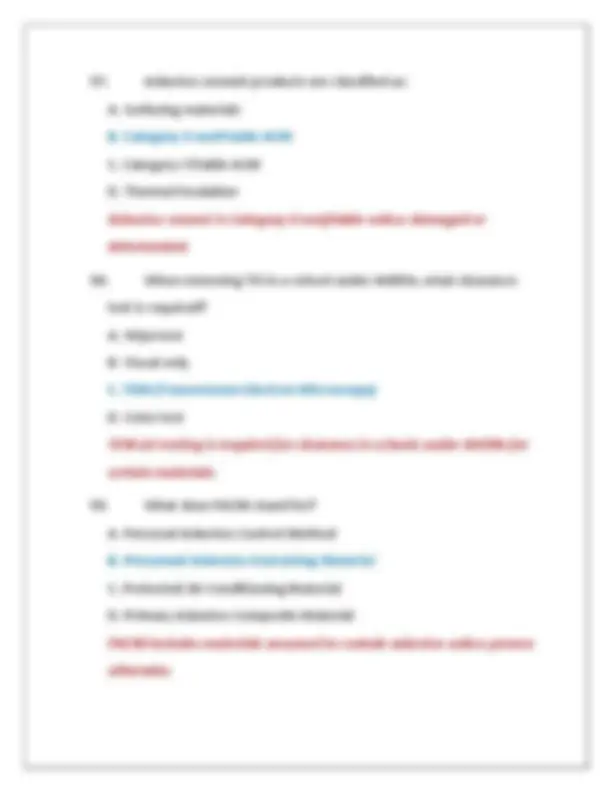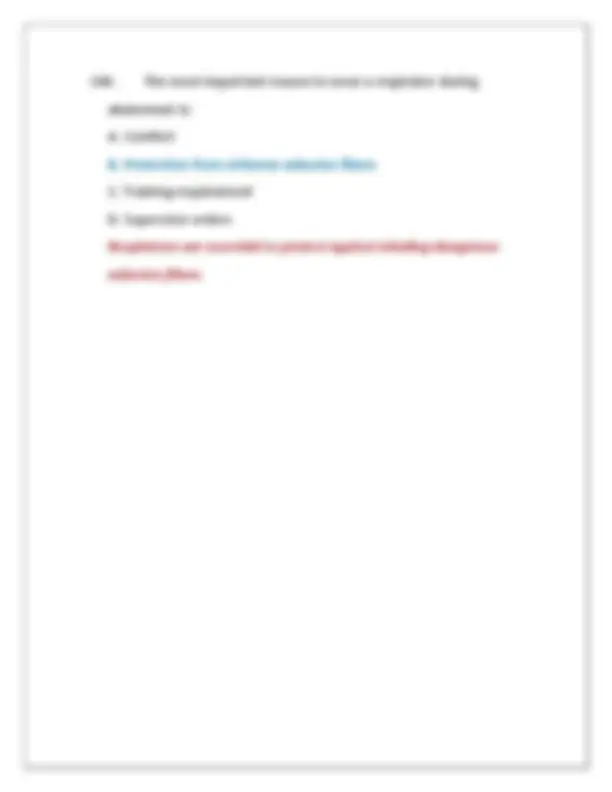Download AHERA ASBESTOS WORKER CERTIFICATION PRACTICE EXAM 1 QUESTIONS AND CORRECT ANSWERS (VERIF and more Exams Environmental Engineering in PDF only on Docsity!
AHERA ASBESTOS WORKER CERTIFICATION
PRACTICE EXAM 1 QUESTIONS AND
CORRECT ANSWERS (VERIFIED ANSWERS)
PLUS RATIONALES 2025 Q&A | INSTANT
DOWNLOAD PDF
- What is the primary health hazard associated with asbestos exposure? A. Lung cancer B. Asbestosis C. Asthma D. Skin irritation Asbestosis is a chronic lung disease caused by inhaling asbestos fibers, which leads to lung scarring and reduced respiratory function.
- Which federal agency is primarily responsible for asbestos regulations in schools? A. OSHA B. EPA
C. CDC
D. DOT
The EPA enforces the Asbestos Hazard Emergency Response Act (AHERA), which applies to schools.
- Which class of asbestos work involves removing thermal system insulation? A. Class IV B. Class III C. Class I D. Class II Class I asbestos work includes activities involving removal of thermal system insulation and surfacing materials.
- What is the permissible exposure limit (PEL) for asbestos fibers over an 8-hour time-weighted average? A. 0.5 f/cc B. 0.2 f/cc C. 0.1 f/cc D. 1.0 f/cc The OSHA PEL for asbestos is 0.1 fibers per cubic centimeter (f/cc) over an 8-hour period.
- Which of the following materials is most likely to contain asbestos? A. Glass insulation B. Vinyl floor tile (older than 1980)
D. Compressed air Wetting asbestos materials helps prevent fibers from becoming airborne during removal.
- What is the purpose of a negative pressure enclosure? A. To dry asbestos quickly B. To prevent asbestos fibers from escaping the work area C. To pressurize the work area D. To contain water leaks Negative pressure enclosures help contain fibers within the work area and prevent their release to adjacent spaces.
- Which document outlines the procedures and safety measures for an asbestos abatement project? A. SDS B. Work plan C. Inspection log D. OSHA citation A work plan details all safety procedures, work scope, and engineering controls for asbestos removal.
- Which respirator provides the highest level of protection during asbestos removal? A. Half-face APR B. N95 mask C. Full-face PAPR or supplied air respirator
D. Dust mask Full-face PAPRs or supplied air respirators offer the highest level of protection during high-risk asbestos operations.
- How often must workers be fit-tested for a tight-fitting respirator? A. Once a month B. Every six months C. Annually D. Only once OSHA requires annual fit-testing for tight-fitting respirators to ensure a proper seal.
- How should asbestos-containing waste be labeled? A. With red tape B. With OSHA and DOT warning labels C. With school district name only D. With black marker Asbestos waste must be properly labeled with appropriate warning signs per OSHA and DOT standards.
- What is the purpose of the decontamination unit? A. To store equipment B. For lunch breaks C. To prevent the spread of asbestos fibers D. For emergency medical treatment
Only landfills approved to accept asbestos-containing waste can be used.
- Which of the following is a sign of asbestos-related illness? A. Skin rash B. Shortness of breath C. Blurred vision D. Hearing loss Asbestos exposure typically affects the lungs, leading to breathing difficulties.
- Which of the following is a Class III activity? A. Floor tile removal B. Pipe insulation enclosure C. Maintenance involving ACM disturbance D. Landscaping around a building Class III work involves maintenance or repair that may disturb asbestos-containing material (ACM).
- Which practice is strictly prohibited during asbestos removal? A. Wearing disposable coveralls B. Dry sweeping of debris C. Using HEPA vacuums D. Wetting materials Dry sweeping can release airborne fibers and is prohibited during asbestos work.
- What should be done if a glovebag leaks during removal? A. Continue working and seal it later B. Stop work and replace the glovebag immediately C. Use duct tape over the leak D. Turn off negative air machines A leaking glovebag can release fibers and must be replaced immediately to maintain containment.
- How many layers of polyethylene sheeting are typically required on floors in a full containment? A. One B. Two C. Three D. Four At least two layers of 6-mil polyethylene sheeting are typically used to protect surfaces and contain debris.
- When must a final visual inspection occur? A. Before glovebag installation B. After gross removal and prior to clearance sampling C. Before starting air monitoring D. After decon setup A final visual inspection ensures all asbestos materials and residue are removed before air clearance.
- In which class of asbestos work is glovebag use common? A. Class I B. Class III C. Class IV D. Class II Glovebags are typically used for small-scale, short-duration Class III maintenance tasks.
- How is an asbestos-containing glovebag disposed of after use? A. Reused if not torn B. Sealed in a labeled asbestos waste bag C. Incinerated D. Washed for reuse After use, glovebags must be treated as contaminated waste and sealed in labeled bags.
- What is the purpose of wet wiping surfaces during final cleanup? A. To polish surfaces B. To remove settled fibers C. To disinfect D. To dry materials Wet wiping helps remove residual asbestos fibers and reduce airborne recontamination.
- Who is responsible for ensuring all workers are trained in asbestos safety?
A. The EPA B. The employer C. The building owner D. The equipment supplier Under OSHA regulations, the employer must ensure all workers are properly trained.
- Which work practice minimizes disturbance of asbestos- containing materials? A. Power sanding B. Wet methods and manual removal C. Compressed air cleaning D. High-speed grinding Wet removal with manual tools reduces the chance of fiber release.
- How long must medical records be kept for workers exposed to asbestos? A. 3 years B. 10 years C. 30 years D. Lifetime OSHA requires medical records related to asbestos exposure be kept for at least 30 years.
- If air monitoring results exceed the PEL, what must be done? A. Continue work
B. Remove it and keep working C. Exit the containment immediately D. Cover with plastic Respirator failure poses a high health risk; workers must leave immediately and correct the issue.
- What is the minimum number of chambers in a full decon unit? A. 2 B. 3 C. 4 D. 1 A three-stage decon unit includes the equipment room, shower, and clean room.
- When should personal air monitoring be performed? A. After abatement B. Before glovebag use C. During the abatement process D. Only at final inspection Personal monitoring during work ensures workers are not overexposed to fibers.
- Which of the following is considered a surfacing material? A. Floor tile B. Ceiling grid C. Spray-applied fireproofing
D. Window caulk Spray-applied fireproofing and decorative coatings are common surfacing ACMs.
- Which asbestos fiber type is most commonly used commercially? A. Amosite B. Chrysotile C. Crocidolite D. Tremolite Chrysotile (white asbestos) is the most widely used asbestos fiber type.
- How should you clean your respirator after use? A. With gasoline B. With bleach C. With mild soap and warm water D. With sandpaper Respirators must be cleaned with mild soap and water to maintain integrity and hygiene.
- What is required on an asbestos waste label? A. Company logo B. Danger warning, “Contains Asbestos,” and handling instructions C. Work permit number D. Supervisor name
- How often must asbestos workers receive refresher training? A. Every 6 months B. Every 2 years C. Annually D. Only once AHERA regulations require annual refresher training for asbestos workers.
- What is the function of a smoke test? A. To detect fire B. To test filter capacity C. To detect air leaks in containment D. To test air flow direction Smoke testing helps identify leaks or weaknesses in the containment barriers.
- Which of the following tasks qualifies as Class II asbestos work? A. Cleaning carpets B. Removal of non-thermal ACM like floor tiles C. Painting over ACM D. Mopping floors Class II work involves removing ACM that is not TSI or surfacing material, such as floor tiles.
- How should ACM debris be handled during removal? A. Break it up for faster removal
B. Place in open containers C. Bag and seal immediately D. Sweep into piles ACM must be wetted and sealed in labeled bags as soon as possible to prevent exposure.
- The primary route of entry for asbestos fibers into the body is: A. Skin absorption B. Ingestion C. Inhalation D. Injection Asbestos fibers are most dangerous when inhaled and can lodge in the lungs, causing disease.
- A supervisor must be present during: A. Any building inspection B. Any Class I or II work C. All administrative duties D. Annual training OSHA requires a competent person (often a supervisor) to oversee Class I and II work.
- What is the appropriate method for testing asbestos in materials? A. Smelling the material B. Polarized Light Microscopy (PLM)
All protective gear is necessary to minimize exposure to asbestos in the work zone.
- What step should follow HEPA vacuuming during final cleaning? A. Start another removal B. Wet wipe all surfaces C. Remove decon unit D. Take off PPE Wet wiping removes any remaining fibers after vacuuming.
- The clearance level for asbestos fibers in schools is: A. 0.5 f/cc B. 0.01 f/cc C. 0.1 f/cc D. 1.0 f/cc EPA requires airborne asbestos levels to be below 0.01 fibers per cubic centimeter for clearance in schools.
- Which statement about asbestos exposure is true? A. Short-term exposure has no risk B. There is no safe level of exposure C. Only smokers are affected D. You can see asbestos fibers in air No level of asbestos exposure is considered completely safe; all exposures carry risk.
- What should you do before entering a containment area? A. Eat a meal B. Inspect PPE and check fit C. Wash hands D. Check temperature Proper PPE inspection ensures protection before entering a hazardous area.
- After exiting the containment area, a worker should first: A. Sit down B. Eat lunch C. Enter the decontamination unit D. Remove boots Decontamination is required to remove asbestos contamination safely before re-entering clean areas.
- What classification does EPA give friable asbestos material? A. Category II nonfriable B. Category I friable C. Nonhazardous D. Category III special waste Friable asbestos can be easily crumbled by hand pressure and is more dangerous.
- What is required before demolition of a structure suspected to contain ACM?

